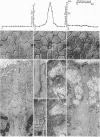Abstract
Epithelia serve as barriers to the diffusion of solutes between body compartments, and must do so despite the frequent loss of cells. When single cells are experimentally removed from the Necturus gallbladder epithelium, contiguous cells migrate to fill the defect within 30 min. Electrophysiological measurements show that the local electrical resistance across the epithelium in the region of a wound returns to normal in the same period of time; electron microscopy demonstrates that tight junctions are formed concurrently. Physiologically functional and morphologically recognizable tight junctions can thus be established within 30 min, demonstrating a mechanism for the rapid restoration of epithelial integrity after cell loss.
Full text
PDF


Images in this article
Selected References
These references are in PubMed. This may not be the complete list of references from this article.
- Asada Y., Bennett M. V. Experimental alteration of coupling resistance at an electrotonic synapse. J Cell Biol. 1971 Apr;49(1):159–172. doi: 10.1083/jcb.49.1.159. [DOI] [PMC free article] [PubMed] [Google Scholar]
- Brightman M. W., Reese T. S. Junctions between intimately apposed cell membranes in the vertebrate brain. J Cell Biol. 1969 Mar;40(3):648–677. doi: 10.1083/jcb.40.3.648. [DOI] [PMC free article] [PubMed] [Google Scholar]
- Claude P., Goodenough D. A. Fracture faces of zonulae occludentes from "tight" and "leaky" epithelia. J Cell Biol. 1973 Aug;58(2):390–400. doi: 10.1083/jcb.58.2.390. [DOI] [PMC free article] [PubMed] [Google Scholar]
- FARQUHAR M. G., PALADE G. E. Junctional complexes in various epithelia. J Cell Biol. 1963 May;17:375–412. doi: 10.1083/jcb.17.2.375. [DOI] [PMC free article] [PubMed] [Google Scholar]
- Friend D. S., Gilula N. B. Variations in tight and gap junctions in mammalian tissues. J Cell Biol. 1972 Jun;53(3):758–776. doi: 10.1083/jcb.53.3.758. [DOI] [PMC free article] [PubMed] [Google Scholar]
- Frömter E., Diamond J. Route of passive ion permeation in epithelia. Nat New Biol. 1972 Jan 5;235(53):9–13. doi: 10.1038/newbio235009a0. [DOI] [PubMed] [Google Scholar]
- Frömter E. The route of passive ion movement through the epithelium of Necturus gallbladder. J Membr Biol. 1972;8(3):259–301. doi: 10.1007/BF01868106. [DOI] [PubMed] [Google Scholar]
- LEBLOND C. P., WALKER B. E. Renewal of cell populations. Physiol Rev. 1956 Apr;36(2):255–276. doi: 10.1152/physrev.1956.36.2.255. [DOI] [PubMed] [Google Scholar]
- Loewenstein W. R. On the genesis of cellular communication. Dev Biol. 1967 Jun;15(6):503–520. doi: 10.1016/0012-1606(67)90050-4. [DOI] [PubMed] [Google Scholar]
- McMahan U. J., Kuffler S. W. Visual identification of synaptic boutons on living ganglion cells and of varicosities in postganglionic axons in the heart of the frog. Proc R Soc Lond B Biol Sci. 1971 Apr 27;177(1049):485–508. doi: 10.1098/rspb.1971.0044. [DOI] [PubMed] [Google Scholar]
- Pappas G. D., Asada Y., Bennett M. V. Morphological correlates of increased coupling resistance at an electrotonic synapse. J Cell Biol. 1971 Apr;49(1):173–188. doi: 10.1083/jcb.49.1.173. [DOI] [PMC free article] [PubMed] [Google Scholar]
- Staehelin L. A. Further observations on the fine structure of freeze-cleaved tight junctions. J Cell Sci. 1973 Nov;13(3):763–786. doi: 10.1242/jcs.13.3.763. [DOI] [PubMed] [Google Scholar]
- Staehelin L. A., Mukherjee T. M., Williams A. W. Freeze-etch appearance of the tight junctions in the epithelium of small and large intestine of mice. Protoplasma. 1969;67(2):165–184. doi: 10.1007/BF01248737. [DOI] [PubMed] [Google Scholar]



